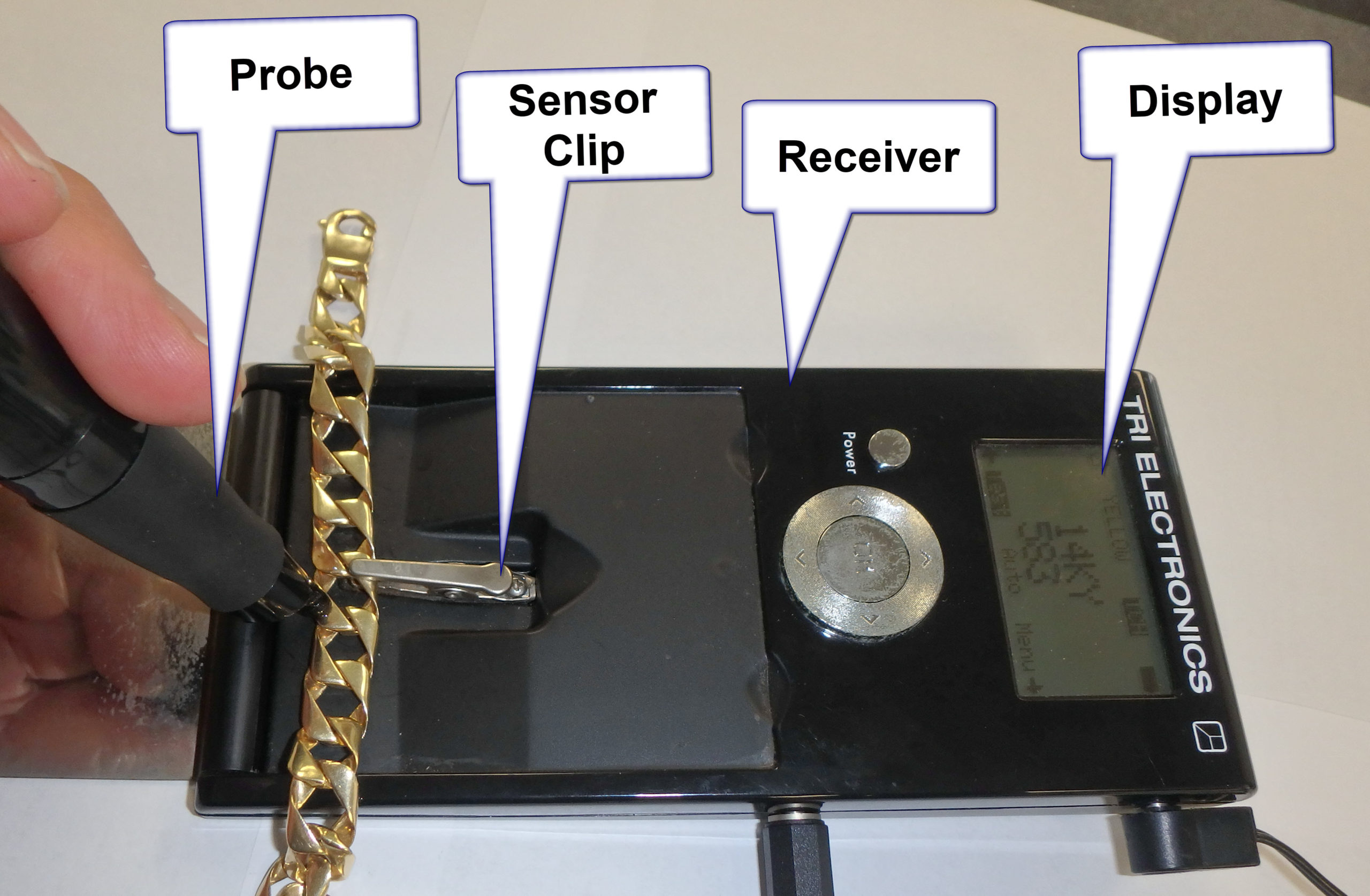ELECTRONIC GOLD TESTERS
Topics Covered:
- Gold Testing Devices I Use
- Other Electronic Gold Testers
- How Electronic Gold Testers Function
- Properly Operating Electronic Gold Testers
- Electronic Gold Tester Accuracy
- Video
Part 1 – How Electronic Gold Testing Works
Part 3 – Testing Gold Electronically
Electronic Gold Testing Devices I Use
I use the following equipment from TRI Electronics. I had another device that did not last long, plus quickly became inaccurate due to what I think are design flaws. I have used other devices.
- GXL 24 Pro
- GXL Next
I have plenty of experience with this gold testing devices. I have been using them almost since 2011. In addition, I had plenty of help with the owner of the company for any gold testing question I needed. Thus, I know a good bit about electronic gold testing, with TRI Electronic devices from the gold buyer point of view.
Other Electronic Gold Testers
A few years ago, around 2011, I bought a Gemoro AuRACLE. Initially the device worked well, but very soon the felt tip tool got contaminated. This is supposed to be solved by re-calibrating the tester to make up for the contamination’s effect. I did this very often. I went through a few felt tip probes. Eventually the receiver started to not work either, so I gave up on the device. I have not tried the newer versions of gold testers by GemOro. I have not tried any other electronic gold testers. I am sure by this time their testers are much improved. Mizar also makes electronic gold testers. I am sure there are additional manufacturers as well.
One of the main plusses of the TRI Electronic is that it dispenses fresh gel through the probe with each testing instance. Thus, there is no contamination of the conducting medium because the gel constantly replaced with.
How Gold Testing Devices Function
To effectively measure a piece of gold jewelry fineness using an electronic tester, it is critical to understand how the device works.
At first sight, electronic gold testing devices look simple and easy to use. And that is true, but with plenty of caveats. Electronic gold testers have three main components. The sensor, the probe, and the receiver. The gold tester’s result reading is based on the electrical loop between these three components.
- At contact, the probe sends an electrical pulse transmitted from the receiver into the subject gold alloy sample. As the electrical pulse passes through the metal, it develops a pattern based on the resistivity of the metal and other factors.
- At arriving to the sensor, the electrical pulse, because all what it encountered on the way, by this time, is of a quite different character than when emitted at the probe. The sensor receives this signal and transfers it to the receiver.
- The receiver processes the input of the sensor in a specialized computer chip. The chip interprets the input by comparing it to the emitted original electrical pulse through an algorithm. Based on that interpretation, a reading is issued and shown in the receiver’s display.
In the TRI Electronics gold testing devices, what links the probe to the test’s subject material is a proprietary liquid conductor medium. Other electronic gold testers have a similar feature. It is this medium that connects the surface of the subject gold alloy to the sensor. The medium is a gel that is just viscous enough to flow through the probe yet sticks to the surface of the tested metal while still in contact with the probe’s electric pulse emitter.
Properly Operating Electronic Gold Testers

To get accurate results from electronic gold testers, it is critical to operate the device properly. Otherwise the results will be off.
At testing a gold-bearing alloy, it is essential to have full contact between the probe, the metal, and the sensor. This is what creates the electrical loop that the electronic gold testing device requires to issue a fineness reading.
- Probe to Tested Gold-Bearing Alloy Metal Connection: Make sure that there is plenty of gel linking the gold tester’s probe with the tested metal. Otherwise, the test results will be inaccurate. When the connection between the probe and the metal is inadequate, the result may be a low reading with respect to actual gold fineness, or the device may even issue a reading as low as “not gold”.
- Tested Gold-Bearing Alloy Metal to Sensor Connection: Make sure that there is a good connection between the tested gold alloy metal and the sensor. In TRI Electronic gold testing devices this is accomplished with stainless steel alligator clip supplied by the TRI Electronics. Do not use another alligator clip. It may affect the test results. Also, make sure that the alligator clip is clean, and there is no rust. I clean that with alcohol. If there is rust, replace the clip. The alligator clip must have full contact grip on the tested metal. If not, the electrical loop will be affected, and the results of the test will be inaccurate, similar to above.
Electronic Gold Testing Device Accuracy
Although not infallible, for some reason electronic gold testing devices are much more accurate in the range of 1OK to 18K gold fineness. I noticed that when testing materials above such fineness, I start getting a degree of inconsistent test results. The GXL 24 Pro and the GXL Next both are rated to 24K. However, given my experience, I do additional due diligence when dealing with over anything over 18K gold.
In the USA, most jewelry is in the range of 10K to 18K fineness, so that is just a fact to be aware of and to act accordingly.
When dealing with gold-bearing alloys of 20K and above, it is important to test the item multiple times. This is when experience comes into play.
My opinion is that most reliable results from the electronic gold testers I use are with 10K to 18K yellow gold. These types of gold-bearing alloys are close 3% silver, the rest copper and gold. More about this phenomenon in Part 3.
Part 1 – How Electronic Gold Testing Works
Part 3 – Testing Gold Electronically


![[Most Recent Quotes from www.kitco.com]](http://www.kitconet.com/charts/metals/gold/t24_au_en_usoz_2.gif)
![[Most Recent Quotes from www.kitco.com]](http://www.kitconet.com/charts/metals/silver/t24_ag_en_usoz_2.gif)
![[Most Recent Quotes from www.kitco.com]](http://www.kitconet.com/charts/metals/platinum/t24_pt_en_usoz_2.gif)










